Marton, Cheshire (†Chester) C.14?
Doom(?)
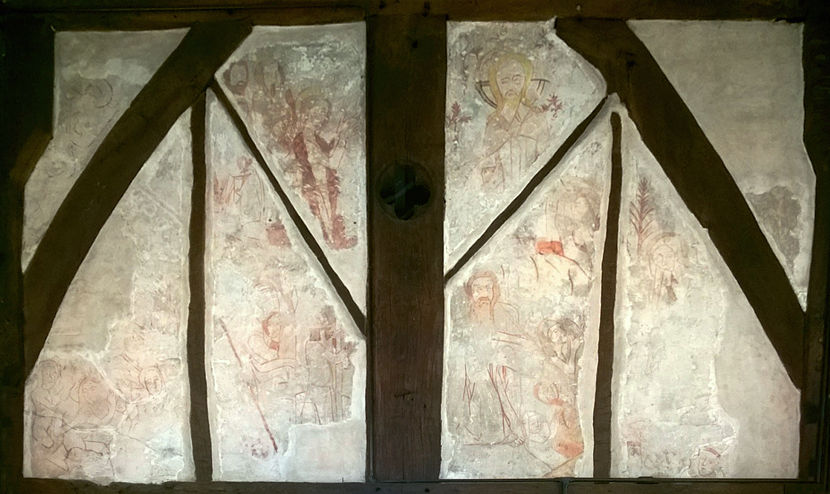
At the left below is the upper right central section of the odd painting, apparently a Doom, above the west door at Marton. The church is a rare example of a genuine half-timbered medieval building and the half-timbering, which divides the painting into segments, can be seen in the photographs.
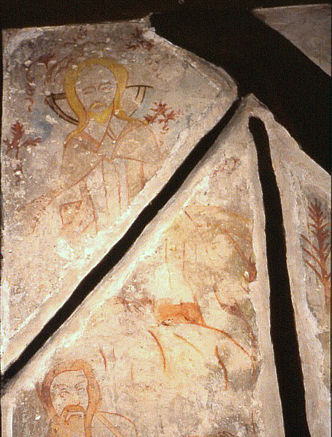
Christ, probably in judgement and with the remains of a large tripartite halo around his long yellow hair, is in the top right corner (shown here at the left). To the right below, beyond the diagonal timber frame, is what looks like part of the curve of the rainbow. Below this is part of Christ’s lower leg, with a large foot. The proportions are distorted to some extent, and the articulation of the figures is sometimes unlikely, presumably because the painter had to work around the timbers.
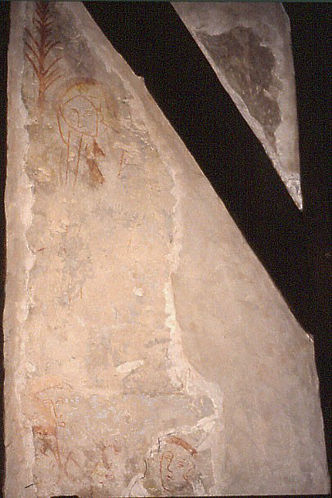
Shown at the right is the far right of the whole triangular design, showing an upright branch with stems and a female figure, possibly with a halo. Whoever this woman is, she is not the Virgin Mary, who is at the other side (unless of course she appears twice, which is unlikely but possible). The lower part of her figure has gone, but the stemmed branch may be intended as the Scourge of the Crucifixion, although another possibility is that it is intended as a native English version of a martyr’s palm (martyrs’ palms in English paintings are sometimes based on familiar, native trees as opposed to the true Mediterranean variety). Below the space where the rest of the female figure would have been is the tonsured head of a priest, and the fragmentary remains of two or three more heads, nearer the centre. Whatever was shown in the small triangle at the top right of the painting has gone completely.
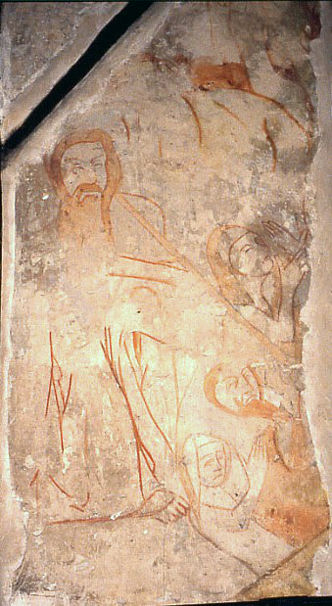
Shown left is the section to the left of this one, and thus part of the central area of the painting, directly below Christ The barefoot and bearded male figure standing at the left holds a long, pole-like object, possibly another Instrument of the Crucifixion – the Lance or the Sponge. This slants to the right across the heads and shoulders of a group of figures, male and female, all in attitudes of prayer and arranged vertically, one above the other. The lowest of them has a face-framing headress and may be a nun or a pious older lady. A stray right hand must belong to a figure now gone with the paint from the plaster at the right hand edge, where a vertical timber divides this central section of the painting from the right ‘wing’ with the female figure and the tonsured head (above).
In the photograph at the right below are the details on the central left side. The top part of this side, above the diagonal timber (below right), shows a group of figures, the most prominent being a woman with a yellow halo who is almost certainly the Virgin Mary. She is probably kneeling, and holds out her hands, open and slightly apart, in supplication of the figure of Christ beyond the broad vertical timber to the right.
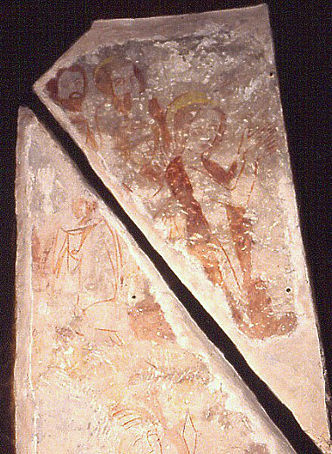
To the left of this figure, by her right shoulder, is another,which I think is also female, although it is possibly St John the Apostle. Two bearded men who are no doubt other Apostles stand behind. This group, then, is facing the Judging Christ to the right, on the same horizontal level but on the other side of the central vertical beam.
Below the diagonal beam and shown below left is another group of people, the largest of them being a man with either a tonsure or a tightly-fitting military coif on his head, holding a very narrow wand-like staff with a diamond-shaped tip or blade. Another man is at the right, holding in his left hand a much broader staff – he too has a vaguely military aspect, and to complicate matters, the head of a third figure, almost certainly male, emerges from below the chin of the first man with the narrow wand. The one thing all these figures have in common is that, with the exception of the bearded barefoot man (top left, above), who looks outwards down the nave of the church, they are looking upwards towards the figure of Christ at the top centre of the painting.
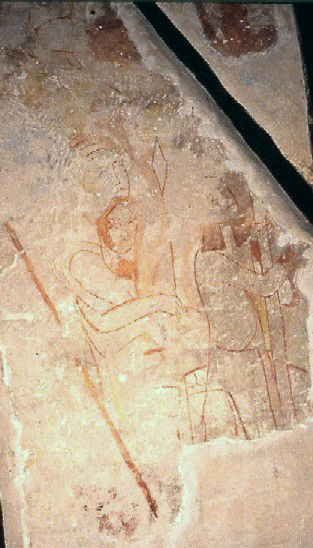
Some or all of the objects held by the various figures shown may be Instruments of the Passion, but it is impossible to be sure about this. Another lance or spear shaft (picture, left), or something similar, emerges on a strong diagonal from beside the timbering dividing this section from the far left – as it stands, this object comes out of nowhere and is connected to nothing, making its significance impossible to comment on. There was probably once a figure behind it.
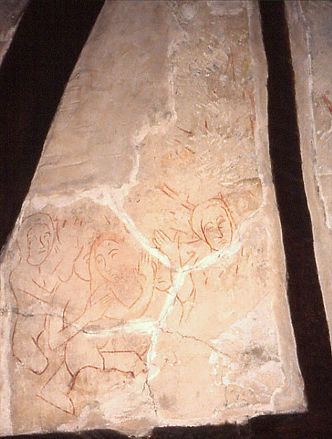
But the people in the final section (below right) at least have a more familiar aspect and are easier to assess. They look very like souls roused at the Last Judgement to meet their final fate, and I think that is, fairly certainly, what they are meant to be. They raise their hands in surprise, wonder, or dismay, and they look out, for the most part, at us, as some figures in Dooms almost always do. This outward gaze is shared, as we have seen, by the bearded figure directly below Christ, and it may be, then, that the object he holds is the tilting balance-bar of the scales and he is thus St Michael, weighing souls. He is not a very typical St Michael, but this is not a very typical painting.
The main part of the building, originally the chapel of Marton, dates from 1343, and it became a parish church in 1370. Architecturally, Marton is fairly well documented – Nikolaus Pevsner called it ‘one of the architectural gems of Cheshire’ – and so is its 18th century painting of Moses and Aaron with the Ten Commandments. But this painting of the Doom was only discovered, under a false façade of plaster, in 1930, and information about it is scanty. I am trying to find out more.